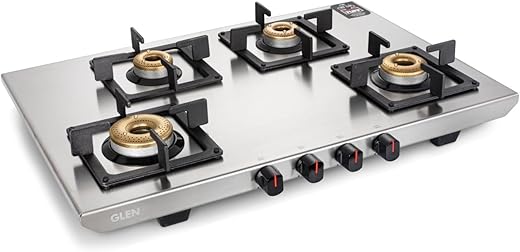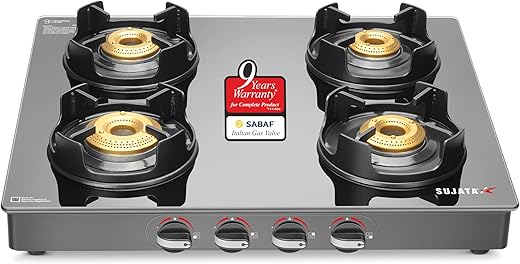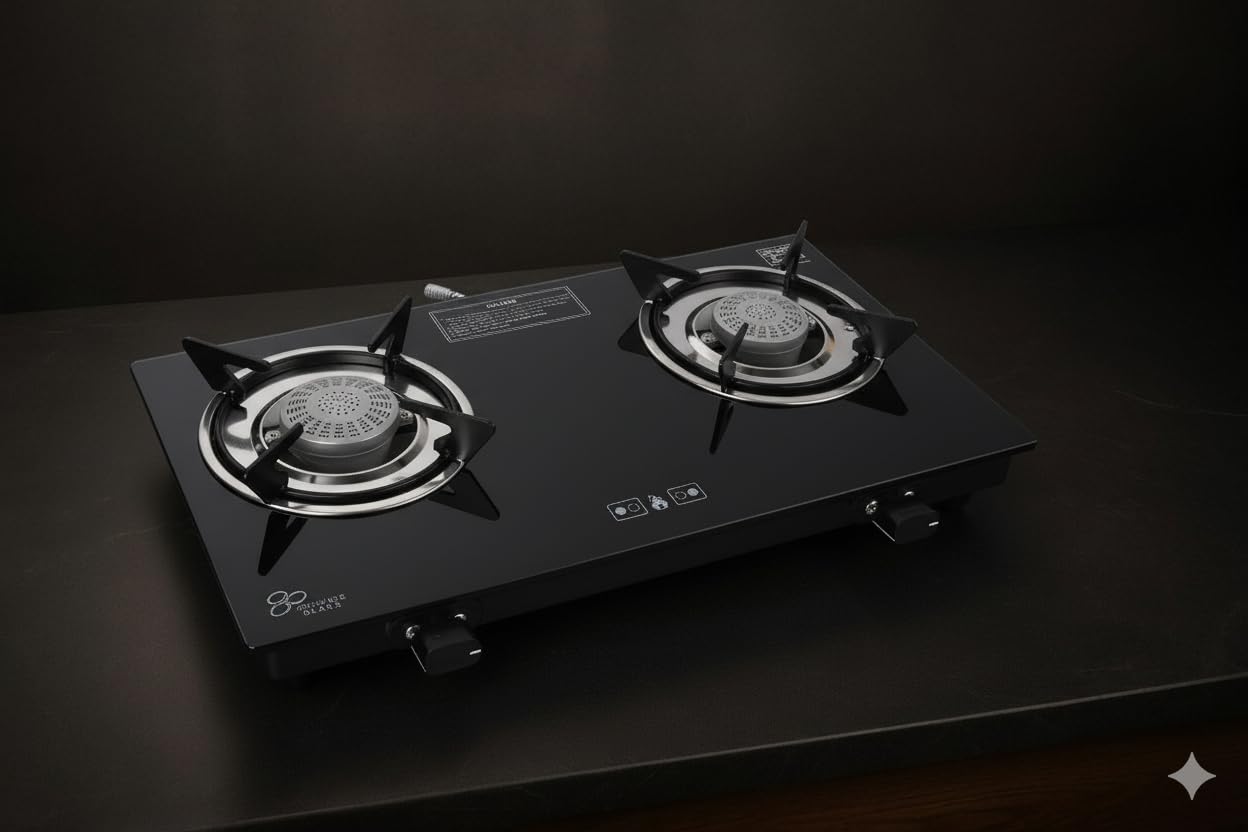LPG vs PNG Cooktop: Comparison, Cost & Safety Guide
Choosing the right fuel source for your gas cooktop is a long-term decision that impacts convenience, cost, and safety in the kitchen. In India, the two primary options are LPG (Liquefied Petroleum Gas), supplied in cylinders, and PNG (Piped Natural Gas), supplied directly via pipelines.
While both are hydrocarbon fuels used for cooking, their delivery mechanisms and physical properties lead to significant differences in usage and performance.
Key Differences: LPG Cooktop vs. PNG Cooktop
| Feature | LPG Cooktop (Cylinder Gas) | PNG Cooktop (Piped Gas) |
| Fuel Composition | Propane and Butane mix, stored as a liquid under pressure. | Primarily Methane (CH4), supplied as gas at low pressure. |
| Supply Method | Delivered in pressurized, portable cylinders (prepaid model). | Delivered continuously through underground pipelines (metered, postpaid model). |
| Supply Reliability | Requires manual booking and cylinder replacement; subject to interruptions if the reserve cylinder runs out. | Continuous, uninterrupted 24/7 supply; no need for booking or storage. |
| Calorific Value (Energy) | Higher (≈93 MJ/m3). Produces a hotter flame and enables faster cooking, essential for high-heat Indian cuisine. | Lower (≈38 MJ/m3). Lower flame temperature and heat output, which can result in slightly slower cooking times. |
| Fuel Cost | Generally Higher per unit of energy, subject to market fluctuations (subsidies can alter effective cost). | Generally Lower per unit of energy, metered and paid based on consumption. More cost-effective in the long run. |
| Safety in Leakage | Heavier than air. Leaks settle near the floor and can accumulate, increasing the risk of fire/explosion. Odor added for easy detection. | Lighter than air. Disperses quickly into the atmosphere, significantly reducing accumulation risk. Odor added, but the quick dispersal makes it generally safer. |
| Space & Portability | Requires significant storage space for one active and one backup cylinder. Fully Portable. | Requires negligible space (only a small meter and pipe). Not Portable (fixed to the pipeline). |
| Availability | Widespread across India, in both urban and rural areas. | Limited to metropolitan cities and urban areas with established pipeline infrastructure, but expanding rapidly. |
| Appliance Required | LPG cooktop with a small gas jet/nozzle (designed for high pressure). | PNG cooktop or an existing LPG cooktop retrofitted with a larger gas jet/nozzle (designed for lower pressure). |
Swipe left or right to see the whole table on mobile devices.
Understanding the Energy and Efficiency
A critical point of comparison is the Calorific Value.
- LPG’s High Calorific Value means it releases more heat energy per unit volume, which is why an LPG flame feels hotter and cooks food faster. For specific high-heat Indian cooking methods (like deep frying or searing), LPG offers a performance advantage.
- PNG’s Lower Calorific Value means it is less energy-dense, requiring the cooktop burner to be adjusted (larger jet) to maintain sufficient flow for cooking. While modern PNG stoves are highly efficient, some users transitioning from LPG may perceive the flame as slightly less powerful.
The Financial Aspect: Initial vs. Running Costs
| Cost Factor | LPG Cylinder User | PNG Piped Gas User |
| Initial Cost | Low (Cost of stove, regulator, and refundable deposit for cylinders). | High (Non-refundable and refundable installation/security charges for pipeline connection and meter). |
| Running Cost | Prepaid model. Higher per unit cost, but price is fixed per cylinder. | Postpaid model. Lower per unit cost, leading to lower monthly bills over the long term. |
| Savings Potential | Limited, relies on government subsidies. | High over time, due to continuous supply and lower net unit price. |
Swipe left or right to see the whole table on mobile devices.
The Transition: Converting Your Cooktop
If you switch from LPG to PNG (or vice versa), you cannot use the same cooktop without modification.
- LPG to PNG Conversion: Your LPG stove must be converted by an authorized technician. The technician replaces the burner nozzle/jet with a slightly wider one to accommodate the lower pressure and calorific value of PNG.
- PNG to LPG Conversion: The reverse conversion is also required, replacing the jet with a smaller one to handle the higher pressure of LPG.
Crucial Note: Always use a qualified and authorized service technician for conversion. Using an unmodified stove with the wrong gas type is dangerous and highly inefficient.
Which Fuel Should You Choose?
The decision between LPG and PNG for your household ultimately depends on your location and priorities:
| Choose LPG Cooktops if… | Choose PNG Cooktops if… |
| Availability is an issue (living in rural or semi-urban areas without a pipeline network). | Uninterrupted supply is your top priority (tired of booking cylinders). |
| You require maximum heat output and the fastest cooking performance. | You seek long-term savings and the predictability of monthly metered billing. |
| You need portability (e.g., you relocate frequently or need to move the stove). | Kitchen space saving is important (no bulky cylinders required). |
| You prefer a prepaid fuel model (pay per cylinder). | You live in a metro or Tier 1/Tier 2 city with established PNG pipeline infrastructure. |
Swipe left or right to see the whole table on mobile devices.
❓ Frequently Asked Questions (FAQs) on LPG vs. PNG Cooktops
This section addresses the most common and crucial questions Indian consumers have when choosing between LPG (Liquefied Petroleum Gas) and PNG (Piped Natural Gas) for their domestic cooktops.
1. Performance and Efficiency
| Question | Answer |
| Which gas offers a faster, hotter flame for cooking? | LPG (Liquefied Petroleum Gas) offers a higher calorific value (≈93 MJ/m3) than PNG (≈38 MJ/m3). This results in a hotter flame and faster cooking, which is often preferred for high-heat Indian cooking methods like frying and boiling. |
| Is a PNG stove less efficient than an LPG stove? | No, but it is less energy-dense. While the flame may appear slightly less intense, a properly retrofitted PNG stove maintains comparable cooking efficiency. The lower energy density of PNG requires a larger gas jet/nozzle for optimal combustion. |
| Do I need to change my entire cooktop if I switch from LPG to PNG? | No, you typically do not need a new cooktop. However, your existing LPG cooktop must be retrofitted by an authorized technician. This involves replacing the small gas jet (nozzle) to accommodate the lower pressure and higher volume requirements of PNG. |
| Can I use my LPG gas stove with a PNG connection directly? | No, absolutely not. Using an LPG stove with a PNG connection without changing the gas jets will result in a very low, inefficient flame due to the pressure difference. More importantly, using a PNG stove with an LPG cylinder is highly dangerous and can cause safety hazards. |
Swipe left or right to see the whole table on mobile devices.
2. Cost and Billing
| Question | Answer |
| Which fuel is cheaper: LPG or PNG? | In the long run, PNG is generally more cost-effective per unit of energy. While LPG cylinders (especially subsidized ones) can appear cheaper upfront, PNG is metered based on actual consumption (postpaid model) and is typically cheaper on a per-unit basis, leading to long-term savings. |
| What is the initial setup cost for a PNG connection? | The initial cost for PNG is higher than LPG. It typically includes a one-time non-refundable connection fee and a refundable security deposit for the meter and installation infrastructure. These charges vary significantly by city and distribution company. |
| How does PNG billing work? | PNG operates on a metered, postpaid model, similar to electricity. A gas meter measures your consumption in Standard Cubic Meters (SCM), and you are billed monthly or bi-monthly based on your actual usage and the prevailing rate. |
| Is the price of PNG subject to the same fluctuations as LPG? | While both are influenced by global natural gas prices, PNG prices tend to be more stable and less volatile than the heavily fluctuating prices of domestic LPG cylinders, which are often tied to international crude oil rates and subsidy changes. |
Swipe left or right to see the whole table on mobile devices.
3. Safety and Convenience
| Question | Answer |
| Which is safer: LPG or PNG? | PNG is generally considered safer. Since PNG (Methane) is lighter than air, it disperses quickly into the atmosphere in case of a leak. LPG (Propane/Butane) is heavier than air and tends to settle near the floor, accumulating and increasing the risk of fire or explosion. |
| Is PNG available everywhere in India? | No. PNG availability is limited to cities and urban areas where the local City Gas Distribution (CGD) company has laid the necessary underground pipeline infrastructure. LPG is widely available across both urban and rural India. |
| What is the main convenience advantage of PNG? | Uninterrupted supply. With PNG, you have a continuous flow of gas 24/7 and never have to worry about running out mid-cooking, booking a refill, or storing heavy cylinders. |
| Can I keep a backup LPG cylinder after getting a PNG connection? | Yes, many distribution companies allow consumers to retain a backup LPG cylinder for emergencies or specific high-heat cooking needs. However, there may be specific safety regulations regarding where and how the cylinder is stored. |
Swipe left or right to see the whole table on mobile devices.
Gas Cooktops: Today’s Top Deals

Elica Slimmest 4 Burner Gas Stove | 904 CT VETRO 2J (TKN CROWN DT MI) | Forged Brass Burners | Euro Coated Pan Support | Double Drip Tray |…

Blowhot Auto Ignition 3 Burners Gas Stove Cooktop for Kitchen (ISI Certified)- 1 Year Warranty, High Power Tornado Brass Burner, Toughened Glass…

Glen Gas Stove 4 Burner Ultra Tuff Stainless Steel LPG Gas Stoves | Manual | Silver | Forged Brass Burner | Revolving Inlet Nozzle | 2 Years…

Sujata Deluxe Gas Stove | 9 Years Warranty | Gas Stove 4 Burners Glass Top, 4 Burner Stove, Manual Ignition, SABAF, ISI Certified, LPG & PNG…

Bajaj UCX 2B Powder Coated Glasstop Gas Stove | 2 Burners | Black | Manual Ignition Cooktop Modern Glass Stove for Modular Kitchen, ISI Certified &…

Vidiem Gas Stove Viva (Silver & Black) | 3 Burner Stainless Steel | ISI Certified | Manual Ignition | 5 Years Warranty (3 burner)

Thermador Super Sleek Gas Stove 2 Burners|Permium Gas Saver Tornado Burner 2 Burner Gas Stove| Manual Ignition|LPG Compatible Gas Chulha|ISI…

Kutchina Pluto 3B Cooktop Gas Stove – 3 Burner Manual Ignition | ISI Certified Glass Top | 1 Year Warranty

Sujata Premium Gas Stove Auto Ignition | 9 Years Warranty | Gas Stove 4 Burners Glass Top, SABAF, ISI Certified, LPG & PNG Compatible, 360°…

BLOWHOT Premium Design Emerald 3 Burners Auto Ignition Gas Stove (ISI Certified) – 1 Year Warranty, Heavy Tornado Brass Burner, Thick Toughened…

Haute Evoque Series 2.0 Black 4 Burner Manual Ignition Glass Gas Stove |8mm Atom Glass || Door Step Service | 5 years warranty on Burner, Glass,…

Crompton FlameStar 3 Burner Glass Top LPG Gas Stove | 1 Jumbo & 2 Medium Brass Burner | Max Space | Easy Cleaning | Toughened Glass | Tri Pin…

Sunflame Optra 4 Burner Gas Stove | Curved Edges Stainless Steel Body | 2 Medium and 2 Small Brass Burners | 2-Years Product Coverage by Sunflame |…

Butterfly Smart 4 Burner Glass Top Gas Stove | Manual Ignition | Scratch Resistant Toughened Glass | Brass Burners | Skid-proof Legs | 1 Year…

Stuffa Gas Stove Single Burner Chulha LPG 1 Burner Stainless Steel Star, ISI Certified, Manual Ignition, Silver 1 Year Doorstep Warranty

Prestige IRIS Toughened Glass-Top 3 Brass Burner LPG Gas Stove | Black Spill Proof Design | Ergonomic Knob | Tri-Pin Burners |Open



